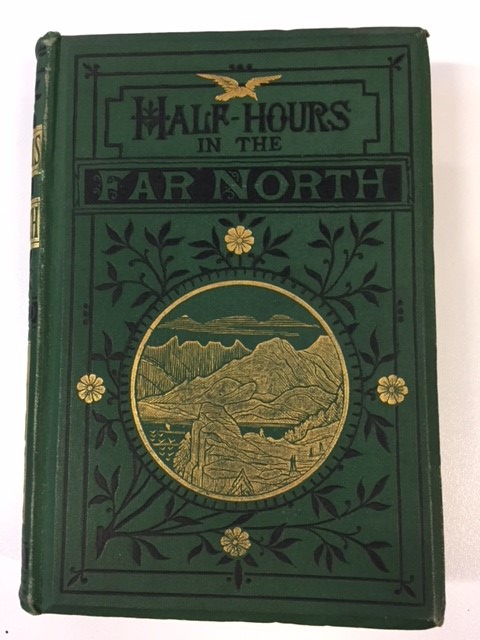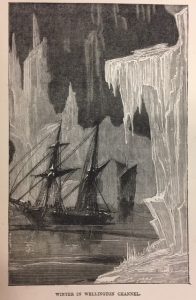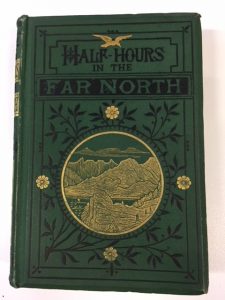
I found this attractive green and gold volume entitled Half-Hours in the Far North: Life amid snow and ice in the Canterbury Christ Church University Special Collections. It was published in 1881 by William Isbister of Ludgate Hill, a Scottish publisher who had started his career working for Alexander Strahan. The book is a lively account of a series of voyages to Iceland, Northern Russia, Greenland, Orkney, Shetland, the Arctic Seas and Norway including ethnographical, geographical and ornithological descriptions. It is part of a series entitled The Half-Hour Library of Travel, Nature and Science which includes titles on sport and travel, the Deep, the Far East, insects, and the Tropics. The series includes high-quality illustrations but several of the books are uncredited. The titles were aimed at young readers and each volume cost 3s 6d.
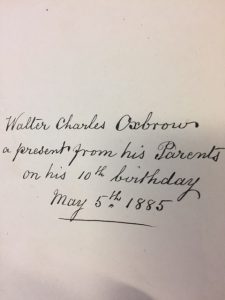
This copy was given to Walter Charles Oxbrow on his 10th birthday on the 5th May 1885. Walter lived at 35, Burgate, Canterbury, three doors away from the Cathedral gate, with his parents and his older brother, Alfred.[i] His father owned a watch and clockmakers. Adverts from the time reveal that the shop also sold jewellery, optical and electro-plated goods.[ii] Across the street from their shop was Austen’s, a bookseller and stationers, and it is possible that the present was purchased there. Walter would have no doubt marvelled at the stories of adventures in foreign lands: tales of Eskimos, dog-sledges, fiords, glaciers and the aurora borealis.
I was curious to know more about the voyages described in the book and how they might have influenced their young reader. In order to do this, I decided to work out who had written the account. How hard can this be, I thought? I was about to find out. I started by looking for information about the publisher William Isbister. I quickly uncovered an article on JSTOR written by Bradford Booth entitled: ‘Author to Publisher: Anthony Trollope and William Isbister’ Princeton University Library Chronicle 24 no.1, 1962. In it, I discovered that Isbister’s letters and papers are held at Princeton University and include 48 letters from Anthony Trollope, who having retired from his job in the Post Office, was supplementing his income writing travel books, biographies and articles.[iii] I got widely excited when I read that Trollope had been to Iceland in June 1878, and wondered whether he contributed or indeed had written Half-Hours in the Far North, but with further research I learned that Trollope had written an account of his voyage entitled How The ‘Mastiffs’ Went to Iceland which was published by J.S. Virtue and Co. in 1878. 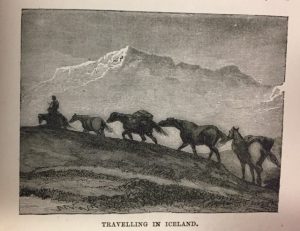 I still naively clung to the hope that Trollope was the author of Half-Hours in the Far North. However, on reading the account of the voyages in both books I realised I was barking up the wrong tree. The voyage in Half-Hours begins at Liverpool docks on a calm evening, the Mastiff set off from Castle Wemyss, on the Firth of Clyde.[iv] It was back to the drawing board. Although I knew the author of Half-Hours in the Far North couldn’t be Trollope, I decided to read the Trollope letters in Bradford Booth’s article, as I hoped to learn more about William Isbister.
I still naively clung to the hope that Trollope was the author of Half-Hours in the Far North. However, on reading the account of the voyages in both books I realised I was barking up the wrong tree. The voyage in Half-Hours begins at Liverpool docks on a calm evening, the Mastiff set off from Castle Wemyss, on the Firth of Clyde.[iv] It was back to the drawing board. Although I knew the author of Half-Hours in the Far North couldn’t be Trollope, I decided to read the Trollope letters in Bradford Booth’s article, as I hoped to learn more about William Isbister.
In January 1879, Trollope wrote to Isbister:
“You ordered from 5 to 6,000 words to be ready on the 6th instant for Good Words – about hunting, and all good words, and fit for Good Words. Yours always Anthony Trollope. Let me have a line to say that they have reached you. Is there to be any naming title, such as “Half-Hours in the open air?” Supposing that there will be such, I have called my paper “In the hunting field.” (5th January 1879).[v]
I decided to find out more about Good Words as the reference to “Half-Hours” was too tantalising. Good Words, a periodical containing moral stories and non-fiction designed for a non-conformist audience had been founded in 1860 by Alexander Strahan, Isbister’s former employer. By searching its contents on ProQuest’s Periodicals Collections for articles about Iceland, I was able to find my first clue. An article entitled A Holiday in the Norse Country written by an author with the initials G.H.B had been published in the January 1864 issue. It matched the first chapter of Half-Hours in the Far North word for word. I then searched for articles on Russia and Greenland to see if G.H.B had written those chapters. I was surprised to discover that the chapters were written by different authors.
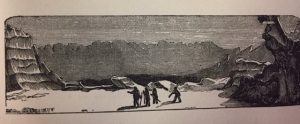 The Russia chapters were originally published as A Peep at Russia and the shores of the Baltic in Good Words in December 1861 by Norman Macleod. Norman had also written the chapter describing the Search for Franklin as The Fate of Franklin in Good Words in December 1860. In the account he mentions that Dr Walker, the ship’s surgeon and naturalist of the expedition, opened a school on board ship. By searching for Walker, I was able to discover David Walker’s account of the journey Days and Nights in Greenland which was published two years later in the December 1862 issue of Good Words.
The Russia chapters were originally published as A Peep at Russia and the shores of the Baltic in Good Words in December 1861 by Norman Macleod. Norman had also written the chapter describing the Search for Franklin as The Fate of Franklin in Good Words in December 1860. In the account he mentions that Dr Walker, the ship’s surgeon and naturalist of the expedition, opened a school on board ship. By searching for Walker, I was able to discover David Walker’s account of the journey Days and Nights in Greenland which was published two years later in the December 1862 issue of Good Words. 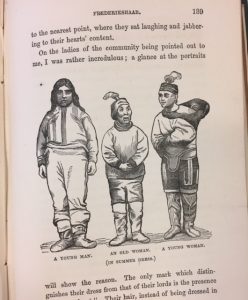 His article provided the text for the chapters on Greenland in Half-Hours in the Far North and his photographs from the expedition were used to illustrate the book. I noted that Norman Macleod was also the editor of Good Words and decided to find out more about him. He had a younger brother George Husband Baird Macleod, a Glasgow surgeon. I had found G.H.B.
His article provided the text for the chapters on Greenland in Half-Hours in the Far North and his photographs from the expedition were used to illustrate the book. I noted that Norman Macleod was also the editor of Good Words and decided to find out more about him. He had a younger brother George Husband Baird Macleod, a Glasgow surgeon. I had found G.H.B.
I was able to find out that another brother, Donald Macleod, had written a biography of Norman’s life which can be found at Hathi Trust. In a description of Norman’s childhood we learn that:
“Ships and sailors were the great object of his interest, and contrary to the wishes of his anxious mother, many a happy hour was spent on board the vessels which lay at the pier… there was not a character in the place – fool or fiddler, soldier or sailor – whose peculiarities or stories they had not learned.”[vi]
His imagination and love of story-telling was apparent from an early age:
“Schoolboy expeditions became under his fanciful and heroic enterprises, in which some ideal part was assigned by him to each of his companions. A sail to some creek a mile away became a voyage of discovery or a chase after pirates. A ramble over the hills took the shape of an expedition against the French.”[vii]
I continued to search Half-Hours in the Far North and Good Words for clues. The chapters on Norway felt quite different in style to the earlier chapters. They were a second person narrative, quite bold in style, and were less detailed. The opening sentence: “Do you wish your lungs to expand, your eyes to dilate, your muscles to spring, and your spirits to leap? – Then come to Norway!” connects with the young reader in a more vibrant way than the Macleods’ more serious, measured tone in the earlier chapters. They were taken from the article by R.M. Ballantyne entitled From Norway in the January 1863 issue of Good Words. R.M. Ballantyne was the prolific Scottish author of children’s fiction, famed for Coral Island, published in 1857. He had already written 57 works by the time that Half-Hours in the Far North was published, so it seemed surprising to me that Ballantyne’s name was not credited in the front of the book. I began to imagine a copyright scandal (oh, librarians and their suspicious minds) and decided I had to find out more about the history of copyright. I quickly realised that it was commonplace for authors to sell on their copyright. Trollope had sold the copyright to The Three Clerks to his publisher Richard Bentley for £250, rather than wait for royalties and in 1870 the copyright of four of Trollope’s novels were sold by J.S. Virtue to Strahan. Trollope who was on Isbister’s lists by the late 1870s wrote:
“I think myself that Isbister is a fair dealing man; but that he understands very little of his trade. He knows the paper and printing part of it. But it is altogether astray as to whether a book will or will not pay.”[viii]
I decided to find out more about who owned the copyright of the chapters in Half-Hours in the Far North. Norman Macleod, who had written the Russia chapters, died in 1872 and Good Words continued under the editorship of his brother Donald, with Messrs Daldy, Isbister and Co as publishers.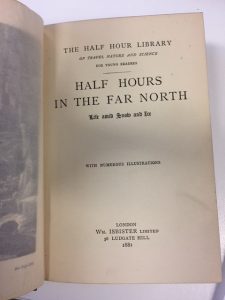 In 1878, William Isbister bought up the copyright of Good Words, the Sunday Magazine and portions of the school books and other publications formerly issued by Messrs Daldy, Isbister and Co for £30,000.[ix] Half-Hours in the Far North had been published earlier it seems in November 1875 and so would have been part of this purchase.[x] With literacy levels rising, children’s fiction was a growing market. Surely Isbister was on to a winner?
In 1878, William Isbister bought up the copyright of Good Words, the Sunday Magazine and portions of the school books and other publications formerly issued by Messrs Daldy, Isbister and Co for £30,000.[ix] Half-Hours in the Far North had been published earlier it seems in November 1875 and so would have been part of this purchase.[x] With literacy levels rising, children’s fiction was a growing market. Surely Isbister was on to a winner?
Moreover, there is evidence that authors were cognisant and compliant to the practice of repackaging their articles into other works. Lieutenant Colonel W.F. Butler whose book Far Out: rovings retold was published by Isbister in 1880 wrote:
“I have been told that an introductory chapter is necessary ere the scattered papers of travel which are here brought together can be taken from the lower region of magazine literature, in which they have hitherto had existence, and with a title bestowed upon them, be elevated or “shelved” into the upper world of books.”[xi]
However, Isbister’s demands may have been too exacting for Trollope who wrote on 28 May 1879:
“I do not care a straw about the “Half-Hours”. I assumed the title in obedience to you and Macleod, – and, having something to say, said it as well as I could in your form. What would he say to “How we write our books,” as a title.”
Nevertheless, it seems extraordinary to the modern reader that a publisher would not capitalise on the name of a popular author. Was Isbister really such a poor business man as Trollope claimed? In another title in the series, Half-Hours in the Far South: the people and scenery of the tropics published in 1877, a chapter about the island of Monos is taken from Charles Kingsley’s Letters from the Tropics published in the May 1870 issue of Good Words. Kingsley, author of the popular children’s book Water Babies published in 1863 had died in 1875. Once again, like Ballantyne, Kingsley was a well-known author yet his work is uncredited. Isbister owned the copyright to four of Kingsley’s books: Madam How and Lady Why, Health and Education, Town Geology and Selections from Writings. He could not have been ignorant of the money that could be made from Kingsley’s writings.
I have been unable to find out whether Isbister made much money from the Half-Hours series. The books were still being advertised in periodicals such as The Relinquary, Temple Bar and Athenaeum as late as 1887 and are described as “readable”, “agreeably written”, “interesting” and “useful”[xii] However, we do know that Trollope wrote repeatedly to Isbister complaining of late payments for his writings, suggesting that Isbister was either disorganised or that the firm was running into trouble.[xiii] In 1883, Isbister retired as manager of the firm leaving his half-brother in charge, yet by 1890 Isbister was declared bankrupt having made “rash and hazardous speculations and contracting debts without means of paying them”.[xiv]
Interestingly, Trollope and Isbister’s former publishing partner Daldy, became members of the International Copyright Commission in 1876 “to make inquiry with regard to the law and regulations relating to home, colonial and international copyright”[xv]. They published a report in 1878, however the commissioners were divided as to copyright’s scope and purpose.[xvi] In 1880 Matthew Arnold writing in the Fortnightly Review argued that the public’s desire for cheap “three shilling books” would erode author’s rights, however due to the exorbitant price of books in general, a change of law was needed, adding that “the system of lending libraries, from which books are hired, will be seen to be, as it is, eccentric, artificial and unsatisfactory in the highest degree.”[xvii] (Oh dear, not a fan of libraries!)
As for Walter Oxbrow, we do not know what he thought about his book, only that it survived the passage of time, but we can imagine that the stories were exciting for a boy living in a small city. By the age of 15, Walter had gone to sea, leaving his brother working in their parents’ shop. Walter sailed as a ship’s apprentice to New York, Mauritius and Sydney, working for the Bay Line Shipping Company, receiving his certificate of competency as a second mate just before his twentieth birthday. He continued in the merchant marine until 1901 when he joined the Imperial Yeomanry to fight in the Boer War, returning to the sea afterwards. Walter’s adventures were to take him all over the world.
You can see a digital copy of Half-Hours in the Far North at the Internet Archive. It was published by Dodd, Mead and Company in America in the 1870s. The bookplate of the digitized copy reveals an interesting story in itself, as it is signed and dated by Raymond B. Montgomery (1910-1988). Raymond was raised in Falmouth, Massachusetts where his mother Priscilla was a librarian at the Marine Biological Laboratory. He later became a scientist on the RV Atlantis and professor of Oceanography at John Hopkins University.
Raymond Montgomery was ten years old when he wrote his name in his copy of the book. The same age as Walter Oxbrow when he was given this book 25 years earlier. Two ten year old boys deeply inspired to travel and adventure by the stories of an earlier era, of stormy seas and purple coasts, who unlike me, probably didn’t care a straw about who authored the book.
Michelle Crowther is the Learning and Research Librarian for Humanities and Languages.
The Library is currently looking for volunteers to work with our archives and special collections so if you are interested in uncovering the stories behind the books, please register your interest at the library point in Augustine House.
[i] “England and Wales Census, 1881,” database with images, FamilySearch (https://familysearch.org/ark:/61903/1:1:Q27W-N3C7 : 11 December 2017), Walter C Oxbrow in household of Alfred Oxbrow, Canterbury St Andrew, Kent, England; from “1881 England, Scotland and Wales Census,” database and images, findmypast (http://www.findmypast.com:n.d.); citing p. 15, Piece/Folio 959/94, The National Archives, Kew, Surrey; FHL microfilm 101,774,443.
[ii] http://www.machadoink.com/BURGATE/35%20Burgate_Alfred%20Oxbrow_pg1.pdf
[iii] https://rbsc.princeton.edu/collections/william-isbister-collection
[iv] Trollope, Anthony, How the “Mastiffs” went to Iceland. (London: Virtue and Co, 1878) https://archive.org/details/howmastiffswentt00trolrich/page/n8
[v] Bradford A. Booth, ed., The Letters of Anthony Trollope. (London: Oxford University Press, 1951), 462 cited in Booth, and Trollope. “Author to Publisher: Anthony Trollope and William Isbister.” The Princeton University Library Chronicle 24, no. 1 (1962): 51. doi:10.2307/26402714.
[vi] Donald Macleod, Memoir of Norman Macleod, D.D. (Toronto: Belford brothers, 1877), 28.
[vii] . Donald Macleod, Memoir of Norman Macleod, D.D. (Toronto: Belford brothers, 1877), 28.
[viii] Bradford A. Booth, ed., The Letters of Anthony Trollope. (London: Oxford University Press, 1951), 462 cited in Booth, and Trollope. “Author to Publisher: Anthony Trollope and William Isbister.” The Princeton University Library Chronicle 24, no. 1 (1962): 51. doi:10.2307/26402714.
[ix] Cornish and Devon Post, September 14, 1878, and October 12, 1878. Gale (accessed March, 29, 2019).
[x] “List of new books,” The Athenaeum, 2508 (1875): 672-3. ProQuest (accessed March, 29, 2019).
[xi] W. F. Butler Far out: rovings retold. (London: Isbister, 1880),vii.
https://archive.org/details/faroutrovingsret00butliala/page/n6 (accessed March 29,2019)
[xii] “The Half-Hour Library.” The Relinquary: quarterly archaeological journal and review, July 1863-Oct.1894 21 (1881): 188. ProQuest (accessed March, 29, 2019).
[xiii] Bradford A. Booth, ed., The Letters of Anthony Trollope. (London: Oxford University Press, 1951), 462 cited in Booth, and Trollope. “Author to Publisher: Anthony Trollope and William Isbister.” The Princeton University Library Chronicle 24, no. 1 (1962): 51. doi:10.2307/26402714.
[xiv] St James’s Gazette, January 28, 1890. ProQuest. (accessed March, 29, 2019).
[xv] The Western Times, April 22, 1876. British Newspaper Archive (accessed January 29, 2019).
[xvi] Primary Sources on Copyright (1450-1900), eds L. Bently & M. Kretschmer, www.copyrighthistory.org
[xvii] Matthew Arnold, “Copyright,” Fortnightly Review, 159, March, 1880, cited in King, Andrew and John Plunket. Victorian Print Media: a Reader. (Oxford: Oxford University Press, 2005):110-118.
 Library
Library Michelle Crowther
Michelle Crowther 1474
1474